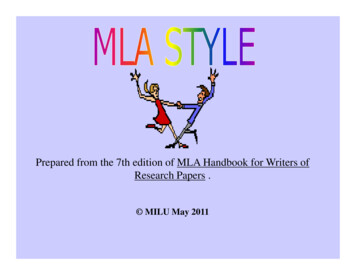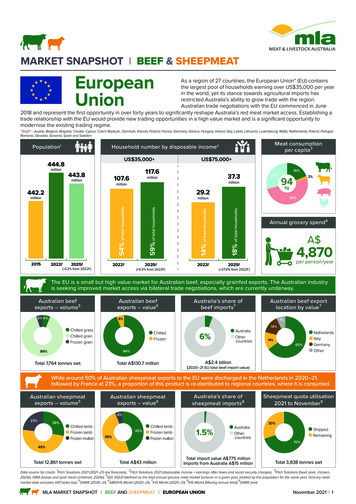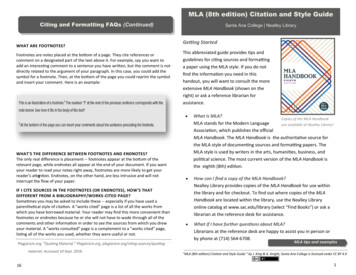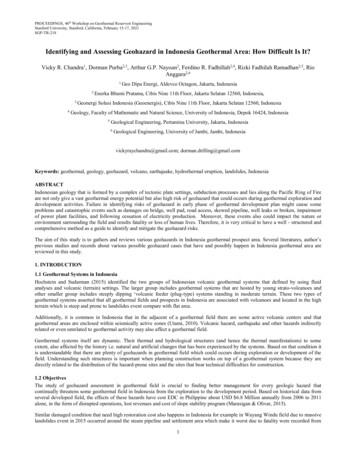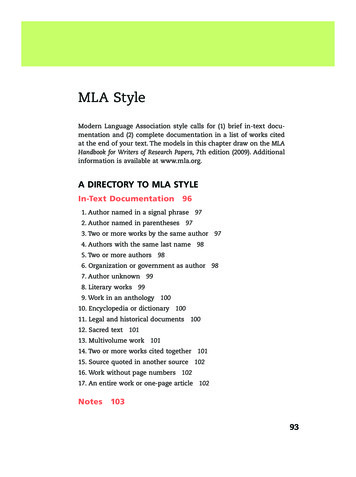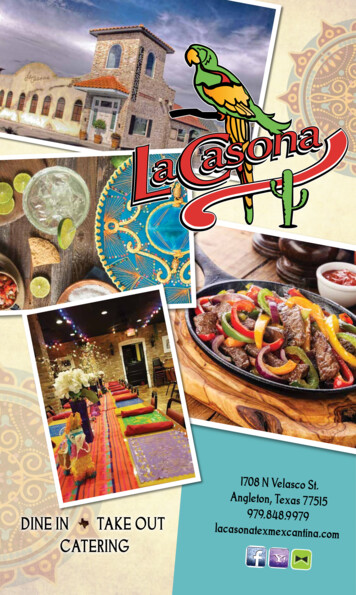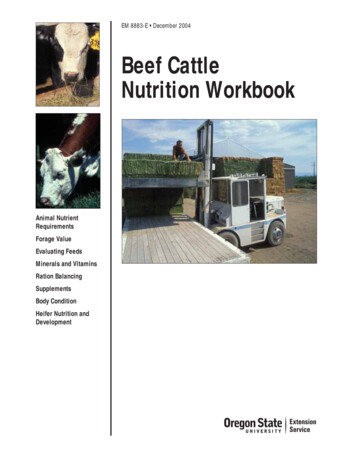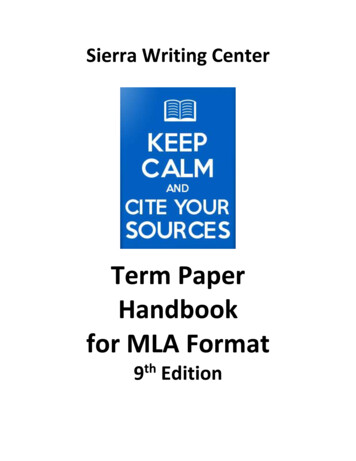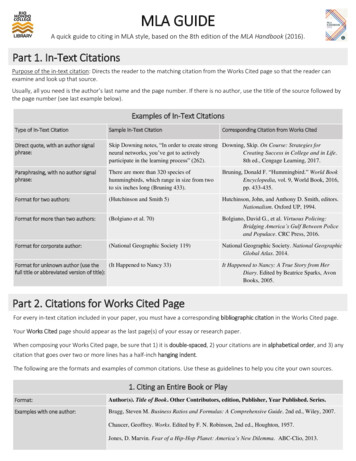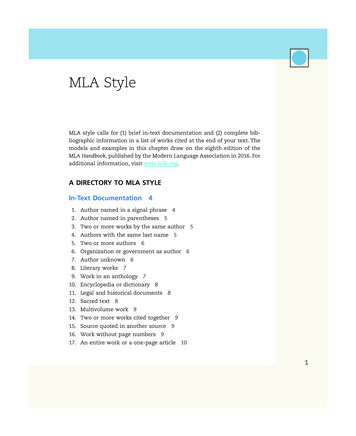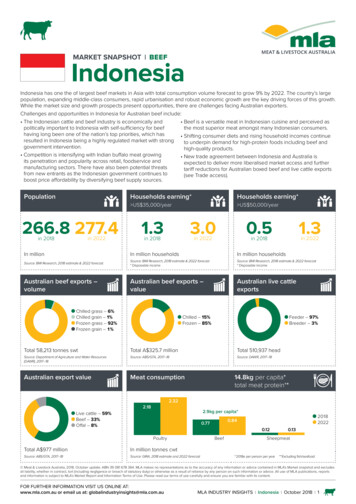
Transcription
MARKET SNAPSHOTBEEFIndonesiaIndonesia has one the of largest beef markets in Asia with total consumption volume forecast to grow 9% by 2022. The country’s largepopulation, expanding middle-class consumers, rapid urbanisation and robust economic growth are the key driving forces of this growth.While the market size and growth prospects present opportunities, there are challenges facing Australian exporters.Challenges and opportunities in Indonesia for Australian beef include: The Indonesian cattle and beef industry is economically and Beef is a versatile meat in Indonesian cuisine and perceived aspolitically important to Indonesia with self-sufficiency for beefthe most superior meat amongst many Indonesian consumers.having long been one of the nation’s top priorities, which has Shifting consumer diets and rising household incomes continueresulted in Indonesia being a highly regulated market with strongto underpin demand for high-protein foods including beef andgovernment intervention.high-quality products. Competition is intensifying with Indian buffalo meat growing New trade agreement between Indonesia and Australia isits penetration and popularity across retail, foodservice andexpected to deliver more liberalised market access and furthermanufacturing sectors. There have also been potential threatstariff reductions for Australian boxed beef and live cattle exportsfrom new entrants as the Indonesian government continues to(see Trade access).boost price affordability by diversifying beef supply sources.Population Households earning* US 35,000/year 266.8 277.4in 2022in 20181.3Households earning* US 50,000/year 0.53.0in 2022in 20181.3in 2022in 2018In millionIn million householdsIn million householdsSource: BMI Research, 2018 estimate & 2022 forecastSource: BMI Research, 2018 estimate & 2022 forecast* Disposable incomeSource: BMI Research, 2018 estimate & 2022 forecast* Disposable incomeAustralian beef exports –volume Australian beef exports –value Australian live cattleexports Chilled grass – 6%Chilled grain – 1%Frozen grass – 92%Frozen grain – 1%Chilled – 15%Frozen – 85%Feeder – 97%Breeder – 3%Total 58,213 tonnes swtTotal A 325.7 millionTotal 510,937 headSource: Department of Agriculture and Water Resources(DAWR), 2017–18Source: ABS/GTA, 2017–18Source: DAWR, 2017–18Australian export value Meat consumptionLive cattle – 59%Beef – 33%Offal – 8%14.8kg per capita*total meat protein** 2.322.182.9kg per capita*Poultry0.12BeefTotal A 977 millionIn million tonnes cwtSource: ABS/GTA, 2017–18Source: GIRA, 2018 estimate and 2022 forecast201820220.840.770.13Sheepmeat* 2018e per person per year** Excluding fish/seafood Meat & Livestock Australia, 2018. October update. ABN 39 081 678 364. MLA makes no representations as to the accuracy of any information or advice contained in MLA’s Market snapshot and excludesall liability, whether in contract, tort (including negligence or breach of statutory duty) or otherwise as a result of reliance by any person on such information or advice. All use of MLA publications, reportsand information is subject to MLA’s Market Report and Information Terms of Use. Please read our terms of use carefully and ensure you are familiar with its content.FOR FURTHER INFORMATION VISIT US ONLINE AT:www.mla.com.au or email us at: globalindustryinsights@mla.com.auMLA INDUSTRY INSIGHTSIndonesiaOctober 20181
Consumers Retail B eef is the third most consumed protein in Indonesia behindchicken and fish. However, it is perceived to be the mostimportant source of protein and is used widely in a variety oftraditional dishes, such as bakso (meatball) and rendang (meatdish cooked with coconut milk).Attributes important for all proteins and beef associationsWhat attributes are important What associations dofor Indonesian consumers (all consumers have to beef?proteins)?Easy and convenient to prepareMost superior meatFreshMy/my family’s favouriteEasy and convenient to purchaseWilling to pay more for this meatTastes deliciousCan be used in many differentmealsTendernessConsistent quality standards Indonesia’s modern grocery retail market is highly fragmentedand only accounts for approximately 7% of the market,however, it is continuously expanding. In Greater Jakarta, consumers generally visit multiple retailchannels from modern to traditional outlets to purchase beef.Australian boxed beef is sold across a range of different retailchannels in the region with supermarkets and hypermarketsbeing the most common places of purchase. The majorityof beef derived from Australian lot-fed cattle is channelledinto wet markets as hot carcases with around 10% sold intomodern retail outlets. The expansion of modern retail to second-tier cities such asSurabaya (the capital of East Java province), Bandung (thecapital of West Java province) and Semarang (the capital ofCentral Java province) presents growth potential for Australianbeef beyond the Greater Jakarta region.Where do consumers go and buy Australian beef in Jakarta?Source: MLA Global Consumer Tracker Indonesia, 2018Supermarket – 43%Hypermarket – 36%Butcher – 10%Wet market – 7%Somewhere else – 3%Online retailer – 2%Convenience store – 1% T he island of Java – the most populated island in Indonesia –accounts for the largest proportion of the country’s total beefconsumption. Australian beef, in particular, is consumed mostlyin Greater Jakarta.Jakarta city profileJakarta cityPopulationGPD per capita2018e2022f10.5 million10.8 millionUS 17,900US 21,200more than 70% of Australian beef isconsumed in the GreaterJakarta regionSource: MLA Global Consumer Tracker Indonesia, 2018Major modern retail chains selling Australian beef inIndonesiaFormatSupermarketHero, AEON, Ranch Market, Farmers Market,Food HallHypermarketHypermart, Carrefour, Lulu Hypermarket,LotteMart, Giant, YogyaGreater JakartaJava IslandJava Island has more than 50% of the Indonesian population andaccounts for more than 70% of total beef consumption in IndonesiaSource: GlobalData, Statistics Indonesia, QASA, MLA estimate I ndonesia has a large, young and diverse consumer base,with more than 60% of its population under 40-years-old(approximately 180 million people). It is also undergoing rapidurbanisation. An additional 13 million people are expected tolive in urban areas by 2022 (Source: BMI Research).Retail banner There has been an emerging trend towards ‘modernisation’and ‘premiumisation’ in the meat retail space across theGreater Jakarta region, driven by a number of leading meatimporters and distributors opening up their own butcher shopswhere a range of high-quality meat products including bothlocally slaughtered and imported beef products are offered. W ith Indonesia being a Muslim-majority country, food beingHalal influences the buying decisions of a large proportionof Indonesian consumers. Beef consumption typically spikesduring the festive seasons, particularly around the months ofRamadan and Idul Fitri. Ramadan dates are based on a lunarcalendar, and migrate throughout the seasons. Subsequently,the timing for beef demand changes every year.Ramadan scheduleYearFirst dayLast day2018May 16Jun 142019May 6Jun 42020Apr 24May 232021Apr 13May 122022Apr 2May 1Note: Ramadan’s start day may vary by country as it depends on when the new moon isfirst sighted.2MLA INDUSTRY INSIGHTSIndonesiaOctober 2018‘Meatshop Indoguna’– a modern butcher shop owned by PTIndoguna Utama, one of the leading meat importers in Indonesia. Indian buffalo meat is mainly sold in wet markets, however, italso presents in supermarkets and hypermarkets with limitedpenetration. Lulu Hypermarket – an Indian-owned and UnitedArab Emirates-based retail chain (entered into Indonesia in2016) – is one of the largest sellers of Indian buffalo meatamongst modern retailers.
Foodservice Other beef suppliers The foodservice channel in Indonesia is diverse, ranging fromhigh-end international restaurants to local family-owned kiosks,known as warungs, and street vendors. Australian beef is widely used in Indonesia’s foodservice sector,mostly within medium to high end restaurants. These are typicallylimited to major cities and tourist destinations, with Jakarta andBali the key markets. Besides small-scale foodservice operators, medium to large-scalelocal foodservice operators have also exhibited preferencestowards Indian buffalo meat as it is cheaper and can be used inplace of beef in a variety of traditional dishes, particularly slowcooked dishes. The Indonesian foodservice market is forecast to grow by 5%through to 2021, partly supported by continued urbanisation,rising incomes and robust tourism growth. The evolvinge-commerce sector is also driving the foodservice market. Gojekand Grap are amongst the leading players expanding their homedelivery services, which offers consumers a wide range of foodchoices, convenience and low delivery costs.Proportion of outlet number and value by key foodservicechannel Indonesia’s initial quota for Indian buffalo meat imports for 2018was 100,000 tonnes with BULOG, a state-owned enterprise,initially appointed as the sole importer. However, additionalimport permits have been granted to PT Berdikari, another stateowned enterprise, with an expected allocation volume of 10,000to 20,000 tonnes, in an attempt to increase the availability ofcheap Indian buffalo meat to broader areas across the country. Indian buffalo meat is priced at around IDR 80,000/kg (A 7.5/kg) for frozen meat, and IDR 95,000/kg (A 8.9/kg) for thawedmeat. It is largely distributed to wet markets, BULOG’s retailstores, and small to medium food manufacturers. New Zealand (NZ) is the third largest beef supplier to Indonesiawith a share of 7% (or 7,000 tonnes from May 2017 to April 2018).NZ beef imports to Indonesia have declined significantly inrecently years (down about 9% per annum on average). Boxed beef imports from the US have increased significantlyfrom a low base. Indonesia imported 5,500 tonnes of US beefduring the period from May 2017 to April 2018 (up 36% year-onyear). The competitive landscape is expected to increase as theValue (OperatorSelling Price)Indonesiangovernmentcontinuously seeks to reduce highbeef No.pricesand diversify beef supply sources with Brazilof outletscurrently being assessed for market access.70605040Beef imports into Indonesia by supplier3010100AccorHotels – 4%Santika Indonesia Hotels & Resorts – 3%Starwood Hotels and Resorts – 2%Swiss-Belhotel International – 2%Aston International Hotels & Resorts – 1%InterContinental Hotels – 1%Other – 87%20302Australia India NZUSAverage value – all marketsAverage value – India2018*Market share of major hotel chains by foodservice sales4402017Source: GlobalData. 2018 2013Accommodation2012Number of ge value – AustraliaSource: GTA, *2018: Moving Annual Total from May 2017 to April 2018.Source: GlobalData, 2016 Despite being fragmented, Indonesia’s foodservice market isevolving towards modernisation, underpinned by the continuedexpansion of shopping malls, modern retail outlets, and hotels;combined with the increasing preferences towards trendy,modern and international dining experiences amongst youngconsumers.Australian beef versus Indian buffalo meat sales promotionBeefsteak at the Holycow Steakhouse – a medium-end steakhousechain in Indonesia.Lulu Hypermarket (Tangerang, Indonesia) – discounted prices at IDR79,900/kg (A 7.5/kg), below the price ceiling for modern retail of IDR80,000 (in February 2018).MLA INDUSTRY INSIGHTSIndonesiaOctober 20183A per kiloFullservicerestaurant‘000 tonnes swt07120202010% India has become Australia’s major competitor in theIndonesian beef market since its legal entry in August 2016.
Live cattle exports Trade access Indonesia accounts for over 50% of Australia’s live cattleexports. In addition, Australian lot-fed cattle have playedan important role in meeting the rising demand for beef inIndonesia. It is estimated to have supplied more than 20% ofIndonesia’s total beef consumption. T he Indonesian government is intensifying its efforts to achievestable beef prices and to boost domestic beef productioncapacity. It has introduced a number of measures and revisionsto existing trade regulations and policies for all boxed beef,offal, and live cattle imports. In 2017–18, Australia exported roughly 510,900 head ofcattle to Indonesia, down 7% year-on-year. The decline wasinfluenced by a range of factors including strong livestockprices in Australia during the second half of 2017, increasedcompetition from Indian buffalo meat, and regulatory complexitysurrounding Indonesia’s live cattle import policies.Boxed beef and offal imports The ‘5:1 feeder to breeder’ import policy, which requiresimporters to import one breeder for every five feeder cattle,came into effect in October 2016. The first audit to evaluateits performance is expected to occur in December 2018, andsubsequently every two years thereafter. A s part of the government’s policy to stabilise beef prices andprovide consumers with access to affordable meat, importersare required to sell cheaper-priced meat, including buffalomeat, in the wet markets. Modern retailers are also required tosell frozen beef at a maximum price of IDR 80,000/kg (aboutA 7.5/kg), effective from 10 April 2017. The Indonesian government is considering the importation ofaround 6,000 head of breeder cattle as part of its efforts toincrease self-sufficiency.Australian live cattle exportsLive cattle 15–162016–172017–18 I mporters obtaining import recommendation are obligated torealise the importation gradually, during a period of validityspecified in the recommendation. Import recommendation iscurrently valid for 12 months.A per head‘000 head1,5000 F ollowing the revised requirements for live cattle imports,effective from 21 February 2017, the maximum average weightfor feeder cattle has been increased from 350kg to 450kg, witha maximum age of 48 months (up from 36 months).500Indonesia and Australia trade relationshipsCattle to IndonesiaCattle to rest of the worldAverage value to IndonesiaAverage value to all markets I ndonesia and Australia have a trade relationship through theASEAN-Australia-New Zealand Free Trade Area (AANZFTA)with tariff reduction remaining a key focus.Source: ABS/GTA T he two countries also have a partnership in the red meat andcattle sector, namely the Indonesia-Australia Red Meat andCattle Partnership (IA-RMCP), a bilateral initiative establishedin 2013. A range of programs have been undertaken tofacilitate the partnership’s core objective which is to maximiseopportunities for development and collaboration between theIndonesian and Australian red meat and cattle sectors.Beef offal exports Besides beef, offal is also widely utilised across household,foodservice and manufacturing sectors in Indonesia. Forexample, tongue is one of the most popular offal cuts used in avariety of Indonesian dishes and tongue root is widely used inthe manufacturing sector. T he Indonesia-Australia Comprehensive Economic PartnershipAgreement (IA-CEPA) was finalised on 31 August 2018. IA-CEPA,on entry into force, will deliver immediate or gradual tariffreductions for those boxed beef and live cattle product linesnot addressed under AANZFTA, and more liberalised accessfor live cattle exports. IA-CEPA’s key outcomes include: Underpinned by the relaxation of beef offal cut restrictionseffective since 2016, and the decline in domestic production,Indonesia’s demand for Australian beef offal has surged.In 2017–18, Indonesia imported roughly 27,800 tonnes andbecame Australia’s largest destination for beef offal Manufacturing*TonguesOtherTotal value2016Heart2017Lips02018LiverLungsSource: DAWR, 2017–18. *Manufacturing includes tongue roots and trimmings.4MLA INDUSTRY INSIGHTSIndonesiaOctober 2018A million‘000 tonnes swtAustralian beef offal exports to Indonesia by major cut0 T he Indonesian government, through the amendment ofMinistry of Trade (MoT) Regulation 37/2016 published in May2016, relaxed restrictions on the importation of secondary cutsof beef and offal, which were imposed in the previous year.Subsequently, most beef cuts are allowed to be imported intothe market. In addition to the cut relaxation, Indonesia openedtrade with foot-and-mouth disease (FMD) countries, notablygranting market access to India.On entry into forceMale cattleTariff: 0% within quota, 2.5% out of quotaQuota: 575,000 head in year one, which will grow 4%per annum over five years to 700,000 head Import permits will be issued automatically on anannual basis and without seasonal restrictions – animprovement on previous administrative procedures.Female cattleTariff: 0% (eliminated from 5%)No quota or import permit restrictionsFrozen bone-inbeefTariff: 2.5% (reduced from 5%) and eliminated afterfive yearsFrozen boneless beef andfrozen beef offal No quota or import permit restrictions for all boxedTariff: 0% (eliminated from 5%)beef and offal product lines
Market access overview Trade agreementsImport tariffsCompetitorsVolume restrictionsTechnical accessASEAN*- Australia-NZFree Trade Agreement(AANZFTA)Indonesia-AustraliaComprehensive EconomicPartnership Agreement(IA-CEPA)Conclusion of negotiationsBoxed beef – 5%on chilled & frozenboneless beef**Live cattle – 5%(0% for purebredbreeding cattle)India (buffalo meat):India-ASEAN FTA. 5% tariffVolumes managed by theIndonesian government’simport permit systemHighly regulated market,with complex importconditions and regulations.The government controlstype of meat and offalproducts that can beimported into the countryBest accessMajor challengesSource: Trade agreements, DFAT, MLA* Association of Southeast Asian Nations. Members include Indonesia, Malaysia, Singapore, the Philippines, Thailand, Vietnam, Brunei, Myanmar, Laos and Cambodia.** Removed by 2023. Chilled and frozen carcase, and chilled bone-in exports are at 0%. Frozen bone-in exports are fixed at 5%.Australian beef exports to Indonesia – summary table Volume – in tonnes swtTotalStorageMeat typeStorage/meat type2017–1858,213% outof total1002016–1750,860% outof total1005-year average(2012–13 to2016–17)% outof total45,804change 2017–18vs 5-year average%in tonnes hilled grassfed3,39163,70373,026712365Chilled grainfed79814631462173336Frozen grassfed53,4619246,4189142,023922711,438Frozen grainfed56412761293192271%in A 000Source: DAWRValue – in A 6,60785246,75084212,387853064,220%in tonnes swtSource: ABS/GTAVolume – by major cut (in tonnes Thick in tonnes swt2036,6661,552Source: DAWRAustralian beef offal exports to Indonesia (in tonnes 423,32710011,84810013515,964%in A 00018350,077Source: DAWRValue – in A 000Total77,49952,96827,422Source: ABS/GTAAustralian live cattle exports to IndonesiaVolume – in head510,937533,906547,086-7-36,149Value – in A 000573,916635,665491,2161782,700Source: DAWR, ABS/GTA5 Meat & Livestock Australia, 2018. October update. ABN 39 081 678 364. MLA makes no representations as to the accuracy of any information or advice contained in MLA’s Market snapshotand excludes all liability, whether in contract, tort (including negligence or breach of statutory duty) or otherwise as a result of reliance by any person on such information or advice. All use of MLApublications, reports and information is subject to MLA’s Market Report and Information Terms of Use. Please read our terms of use carefully and ensure you are familiar with its content.
Mobile Other operator Accom-modation Quick Leisure service restaurant Full restaurant Number of outlets Value Source: GlobalData. 2018 estimate Market share of major hotel chains by foodservice sales AccorHotels - 4% Santika Indonesia Hotels & Resorts - 3% Starwood Hotels and Resorts - 2% Swiss-Belhotel International - 2%
